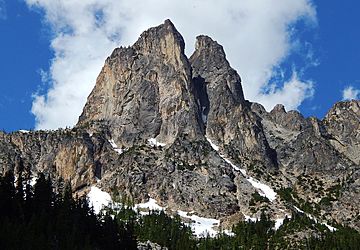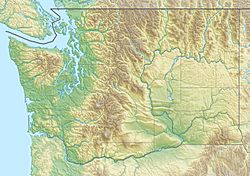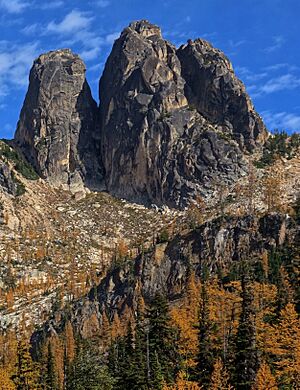Early Winters Spires facts for kids
Quick facts for kids Early Winters Spires |
|
|---|---|

Early Winters Spires
|
|
| Highest point | |
| Elevation | 7,807 ft (2,380 m) |
| Prominence | 647 ft (200 m) |
| Geography | |
| Location | Okanogan County, Washington |
| Parent range | Cascade Range |
| Topo map | USGS Washington Pass |
| Type of rock | (Rapakivi texture) granite |
The Early Winters Spires are two amazing rock towers. You can find them in the North Cascades mountains in Washington state, United States. They stand tall between Liberty Bell Mountain and Blue Lake Peak. These two spires, called North and South, are actually part of one big granite rock. A deep crack splits them apart. This crack was made by things like ice, water, and even tiny bits of acid from the soil over a very long time.
Contents
Exploring the Early Winters Spires
The Early Winters Spires are a popular spot for climbers. They offer exciting challenges for those who love to explore mountains.
North Early Winters Spire
This spire is 7,760 feet (2,366 meters) tall. The very first time someone climbed to the top was on May 28, 1950. The climbers were Wesley Grande, Pete Schoening, and Dick Widrig.
South Early Winters Spire
This spire is a bit taller, at 7,807 feet (2,380 meters). The first people to reach its summit were Kenneth Adam, Raffi Bedayn, and W. Kenneth Davis. This happened on July 20, 1937. However, only Bedayn and Neil Ruge signed the summit register.
Weather Around the Spires
The Early Winters Spires are in a special climate zone. It's called the marine west coast climate. This means the weather is often influenced by the Pacific Ocean. Most of the weather systems come from the Pacific. They travel northeast towards the Cascade Mountains.
When these weather systems hit the tall Cascade peaks, they are forced upwards. This makes them drop their moisture. So, the western side of the North Cascades gets a lot of rain or snow. This happens especially during the winter months.
In winter, it's often cloudy. But in summer, high pressure systems over the Pacific Ocean bring clear skies. The snow here can be wet and heavy. This means there's a higher chance of avalanches. Water from the northeast side of the spires flows into Early Winters Creek. This creek then joins the Methow River. Water from the southwest side flows into a stream that goes to the Chelan River.
How the Mountains Formed
The North Cascades have very rugged shapes. You can see sharp peaks, long ridges, and deep valleys carved by glaciers. The Cascade Mountains started forming millions of years ago. This was during a time called the late Eocene Epoch.
The Earth's plates were moving. The North American Plate was sliding over the Pacific Plate. This caused a lot of volcanic activity. Also, small pieces of the Earth's crust, called terranes, came together. This helped create the North Cascades about 50 million years ago.
Later, during the Pleistocene period, glaciers played a big role. This was over two million years ago. Huge sheets of ice moved across the land many times. They scraped away rock and left behind debris. The U-shaped valleys you see today were carved by these glaciers. The mountains also got taller from uplift and faulting. These processes, along with glaciation, created the tall peaks and deep valleys of the North Cascades.




